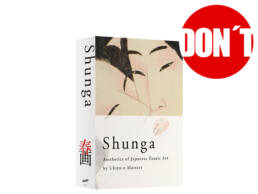Shunga: Aesthetics of Japanese Erotic Art by Ukiyo-e Masters
by PIE International + PIE BOOKS
When this book came out in November 2014, I thought to myself – Yes! Shunga is coming back home. Eager to get a copy of it, I finally got the print in January 2015. When I got it I was all excited, but very soon it turned out in disappointment. Since then I’ve accumulated really bad feelings toward it. Whenever I tried to return to it, to observe some prints or confirm on something it reminded me how this book was badly done.
Let’s start from the beginning. I don’t judge book by its cover, so there is no comment about that. Opening of the book, introductory text by Ishigami Aki (Ph.D.), covers history, mythology and aesthetic of shunga and it perfectly touches all aspects in such a maner that at no point it becomes boring or too academical. There is a certain warm up for the reproductions that we are about to perceive. Ishigami Aki was one of the curators at the British Museum “Shunga: sex and pleasure in Japanese art” exhibition 2013. And every researcher on ukiyo-e and shunga loves the British Museum´s digital collection databases.
One look is better than a hundred words, writes Ishigami Aki, should get us ready for the body of the book, which is around 500 pages of shunga extravaganza. And this is where this book fails. First of all, the pages are not enumerated, automatically there is no Index of the Works and Authors. Secondly, sets of reproductions are introduced by few sentences about the author and set, done by Yamamoto Yukari. I will get back to this as a problem later on. And thirdly, the design of reproductions is just plainly horrible. There is no words to describe randomness of images and the way they were collided. There is no sense of rhythm or meaning of sudden confrontation of highlights/details of genitalia from two different prints, followed by sudden empty page, than full reproduction of second print. A lack of description just emphasises the chaos. I am not saying that reproductions are bad, and the fragrance of the paper is fantastic, but the way it is presented is a total nightmare.
After this, as for the ending, we can read a dialogue between Uragami Mitsuru & Yamamoto Yukari, which is, with Opening by Ishigami Aki, the best part of the book. At one moment Yamamoto Yukari said – People overseas appreciate the extraordinary value of shunga as art; but if you know the background, they are even more interesting, and this is what this book lacks. It is a huge picture book, with no background, and if we get back to One look is better than a hundred words, I would add that a few words could help.
If this book was cut down to 200 pages, with each reproduction commented by Uragami Mitsuru & Yamamoto Yukari, and each highlight/detail of the work was based on those comments, this would be a fantastic book and worth its money. But as it is now it is not really worth the paper it was printed on. If you buy this book you might find it interesting while going through it for the first time, but after that it will just collect dust in your bookshelf, and you will get back to digging through the British Museum´s digital collection databases.PROS:
- It really stands out in a bookshelf.
- Good reproductions (but not enjoyable).
- Fragrance of the paper.
- The introduction and the dialogue are worth reading.
CONS:
- Not really research material.
- Hectic design.
- Expensive, compared to much better books about shunga.
Shunga: Aesthetics of Japanese Erotic Art by Ukiyo-e Masters at PIE BOOKS web site.
Art Direction/Planning/Editing - Takaoka Kazuya;
Introduction - Ishagami Aki;
Short notes on artworks - Yamamoto Yukari;
Dialogue - Uragami Mitsuru & Yamamoto Yukari;
Design - Ito Nobukazu & Saito Yoshiki.


